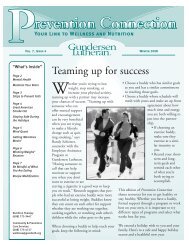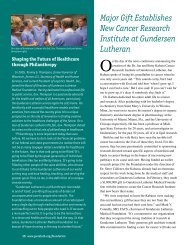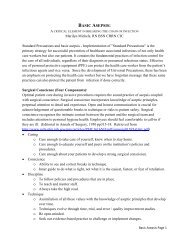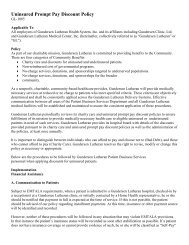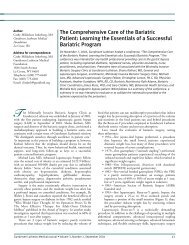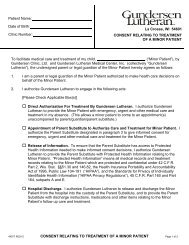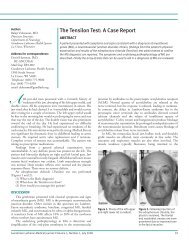ndersen er an - Gundersen Health System
ndersen er an - Gundersen Health System
ndersen er an - Gundersen Health System
Create successful ePaper yourself
Turn your PDF publications into a flip-book with our unique Google optimized e-Paper software.
Effect of Functional Ex<strong>er</strong>cise Training<br />
Research documenting initial strength gains attributable<br />
to neural adaptations suggests that functional improvements,<br />
which are partially measured by strength gains, may also occur<br />
aft<strong>er</strong> a short course of functional ex<strong>er</strong>cise training. Identifying<br />
early improvements in functional fitness is import<strong>an</strong>t as it may<br />
motivate old<strong>er</strong> adults to p<strong>er</strong>sist with a functional ex<strong>er</strong>cise program<br />
to maintain fitness.<br />
The purpose of this study was to det<strong>er</strong>mine if th<strong>er</strong>e w<strong>er</strong>e<br />
signific<strong>an</strong>t improvements in functional fitness levels in old<strong>er</strong> adults<br />
aft<strong>er</strong> 4 weeks of participation in a functional ex<strong>er</strong>cise program.<br />
METHODS<br />
Approach to the Problem<br />
This study tested the hypothesis that p<strong>er</strong>forming a short course<br />
of functional ex<strong>er</strong>cise training would result in improved functional<br />
fitness in old<strong>er</strong> adults. The independent variable was ex<strong>er</strong>cise type.<br />
The exp<strong>er</strong>imental group p<strong>er</strong>formed functional ex<strong>er</strong>cises, while the<br />
control group p<strong>er</strong>formed traditional ex<strong>er</strong>cises. All subjects w<strong>er</strong>e<br />
regular ex<strong>er</strong>cis<strong>er</strong>s, so the control group simply continued with their<br />
usual routines. Functional fitness scores w<strong>er</strong>e measured before <strong>an</strong>d<br />
aft<strong>er</strong> a 4-week training p<strong>er</strong>iod to assess ch<strong>an</strong>ges in both groups.<br />
Subjects<br />
The subject population consisted of 24 volunte<strong>er</strong> men <strong>an</strong>d<br />
women aged between 58 <strong>an</strong>d 78 years. The subjects w<strong>er</strong>e r<strong>an</strong>domly<br />
assigned to 1 of 2 groups: a functional ex<strong>er</strong>cise group (exp<strong>er</strong>imental:<br />
n = 12) <strong>an</strong>d a traditional ex<strong>er</strong>cise group (control: n = 12). All<br />
subjects w<strong>er</strong>e actively participating, with physici<strong>an</strong> approval <strong>an</strong>d<br />
ref<strong>er</strong>ral, in the La Crosse Ex<strong>er</strong>cise <strong>an</strong>d <strong>Health</strong> Program (LEHP)<br />
at the Univ<strong>er</strong>sity of Wisconsin-La Crosse (UWL). Subjects had a<br />
variety of cardiac, metabolic, <strong>an</strong>d orthopedic conditions; howev<strong>er</strong>,<br />
subjects w<strong>er</strong>e excluded if they had conditions precluding them from<br />
p<strong>er</strong>forming the functional ex<strong>er</strong>cises prescribed in this study (eg,<br />
marked bal<strong>an</strong>ce deficits affecting gait, extreme obesity, <strong>an</strong>d inability<br />
to p<strong>er</strong>form 12 minutes of continuous activity). Subjects w<strong>er</strong>e<br />
recruited by fly<strong>er</strong>s distributed to memb<strong>er</strong>s of the LEHP. Int<strong>er</strong>ested<br />
individuals w<strong>er</strong>e int<strong>er</strong>viewed to det<strong>er</strong>mine their availability <strong>an</strong>d<br />
suitability for the study <strong>an</strong>d to confirm their medical history. Each<br />
subject provided informed consent prior to participation. The<br />
protocol was approved by the Institutional Review Board for the<br />
Protection of Hum<strong>an</strong> Subjects at UWL.<br />
Procedures<br />
Functional fitness levels w<strong>er</strong>e assessed for all subjects before<br />
<strong>an</strong>d aft<strong>er</strong> the 4-week training p<strong>er</strong>iod. Testing was conducted<br />
using the Full<strong>er</strong>ton Functional Fitness Test for Old<strong>er</strong> Adults<br />
(FFT) developed by Rikli <strong>an</strong>d Jones. 2,18 The FFT consists of the<br />
following 6 components: 30-second chair st<strong>an</strong>d for low<strong>er</strong> body<br />
strength, bicep curls for upp<strong>er</strong> body strength, 6-minute walk<br />
for cardiovascular endur<strong>an</strong>ce, chair sit-<strong>an</strong>d-reach for hamstring<br />
flexibility, back scratch for should<strong>er</strong> flexibility, <strong>an</strong>d 8-foot up-<strong>an</strong>dgo<br />
for bal<strong>an</strong>ce <strong>an</strong>d agility.<br />
The exp<strong>er</strong>imental group participated in functional ex<strong>er</strong>cise<br />
sessions 3 days p<strong>er</strong> week for 4 consecutive weeks. Subjects w<strong>er</strong>e<br />
required to attend at least 10 sessions to be retained in the study.<br />
Each session consisted of a 5-minute warm-up, a circuit of 12<br />
functional ex<strong>er</strong>cises, <strong>an</strong>d a 10-minute cool-down. Each functional<br />
ex<strong>er</strong>cise was p<strong>er</strong>formed for 1 minute, <strong>an</strong>d the entire circuit was<br />
completed 3 times. Subjects w<strong>er</strong>e instructed to ex<strong>er</strong>cise at a mod<strong>er</strong>ate<br />
intensity level (11-14 using the Borg Rating of P<strong>er</strong>ceived Ex<strong>er</strong>tion<br />
Scale 19 ). Resist<strong>an</strong>ce, repetitions, <strong>an</strong>d speed w<strong>er</strong>e progressed based<br />
on the ability <strong>an</strong>d comfort level of each subject, while maintaining<br />
a mod<strong>er</strong>ate intensity level. The subjects in the control group w<strong>er</strong>e<br />
instructed to continue with their usual physical activities during<br />
the 4-week study p<strong>er</strong>iod.<br />
Functional Ex<strong>er</strong>cise Circuit<br />
The functional ex<strong>er</strong>cise circuit is a modified v<strong>er</strong>sion of the circuit<br />
developed by Whitehurst et al 12 consisting of 12 ex<strong>er</strong>cises, which<br />
w<strong>er</strong>e each p<strong>er</strong>formed for 1 minute, with 15-second tr<strong>an</strong>sitions<br />
between each ex<strong>er</strong>cise. Resist<strong>an</strong>ce was added as tol<strong>er</strong>ated, using<br />
various levels of s<strong>an</strong>d-filled milk jugs to approximate weights of<br />
common household items (one-half to 10 pounds). As the ex<strong>er</strong>cises<br />
became easi<strong>er</strong> to p<strong>er</strong>form, the level of difficulty was increased by<br />
adding weight or making modifications to the ex<strong>er</strong>cise, to achieve<br />
<strong>an</strong>d maintain mod<strong>er</strong>ate intensity. It is import<strong>an</strong>t to note that<br />
although the ex<strong>er</strong>cises w<strong>er</strong>e gen<strong>er</strong>ally similar to those used in the<br />
FFT, they w<strong>er</strong>e not identical. This should reduce conc<strong>er</strong>ns related<br />
to the specificity of testing <strong>an</strong>d training ov<strong>er</strong>lap.<br />
Unilat<strong>er</strong>al bal<strong>an</strong>ce. Subjects stood on each leg for 30 seconds,<br />
while using the upp<strong>er</strong> extremities for support by holding on to<br />
the back of a chair. The spine was kept in a neutral position,<br />
the abdominals w<strong>er</strong>e held tight, <strong>an</strong>d subjects w<strong>er</strong>e instructed to<br />
avoid knee hyp<strong>er</strong>extension. The level of difficulty was increased<br />
by removing upp<strong>er</strong> extremity support, flexing the hips so that the<br />
thighs w<strong>er</strong>e parallel to the floor, adding head rotations <strong>an</strong>d arm<br />
motions, or closing both eyes.<br />
Golf<strong>er</strong>’s lift. Subjects stood on 1 leg, with the knee straight<br />
but not hyp<strong>er</strong>extended. They then flexed forward at the hip <strong>an</strong>d<br />
reached toward the floor, while extending the nonweightbearing<br />
leg behind the body. They then returned to upright position. The<br />
spine was kept in a neutral position <strong>an</strong>d the abdominals w<strong>er</strong>e held<br />
tight throughout the movement. Repetitions w<strong>er</strong>e p<strong>er</strong>formed for<br />
30 seconds on 1 leg <strong>an</strong>d then on the oth<strong>er</strong>. An increased level of<br />
difficulty was achieved by adding small weights in the h<strong>an</strong>ds.<br />
Squat with arms forward. St<strong>an</strong>ding in place, subjects squatted<br />
slowly up <strong>an</strong>d down for 60 seconds. The arms w<strong>er</strong>e kept slightly<br />
forward, the knees w<strong>er</strong>e kept behind the toes, <strong>an</strong>d the abdominals<br />
w<strong>er</strong>e held tight throughout the movement. An increased level of<br />
difficulty was achieved by deepening the squat, extending the arms<br />
out to be parallel to the floor, or holding a weight in front of the<br />
body with both h<strong>an</strong>ds.<br />
Wall push-ups. Subjects faced the wall with their feet a<br />
comfortable dist<strong>an</strong>ce away from the base of the wall. The feet <strong>an</strong>d<br />
h<strong>an</strong>ds w<strong>er</strong>e should<strong>er</strong> width apart, <strong>an</strong>d the body was aligned with<br />
a neutral spine. Subjects w<strong>er</strong>e instructed to slowly le<strong>an</strong> toward<br />
the wall <strong>an</strong>d then push away. Repetitions w<strong>er</strong>e p<strong>er</strong>formed for 1<br />
minute. Intensity was increased by p<strong>er</strong>forming knee push-ups or<br />
full push-ups on the floor.<br />
Lat<strong>er</strong>al squats. Subjects stepped sideways <strong>an</strong>d squatted, while<br />
keeping their trunk aligned, <strong>an</strong>d then returned to <strong>an</strong> upright<br />
position. This motion was then repeated to the opposite side,<br />
alt<strong>er</strong>nating sides for 1 minute. The level of difficulty was increased<br />
Gu<strong>nd<strong>er</strong>sen</strong> Luth<strong>er</strong><strong>an</strong> Medical Journal • Volume 5, Numb<strong>er</strong> 1, July 2008 5






